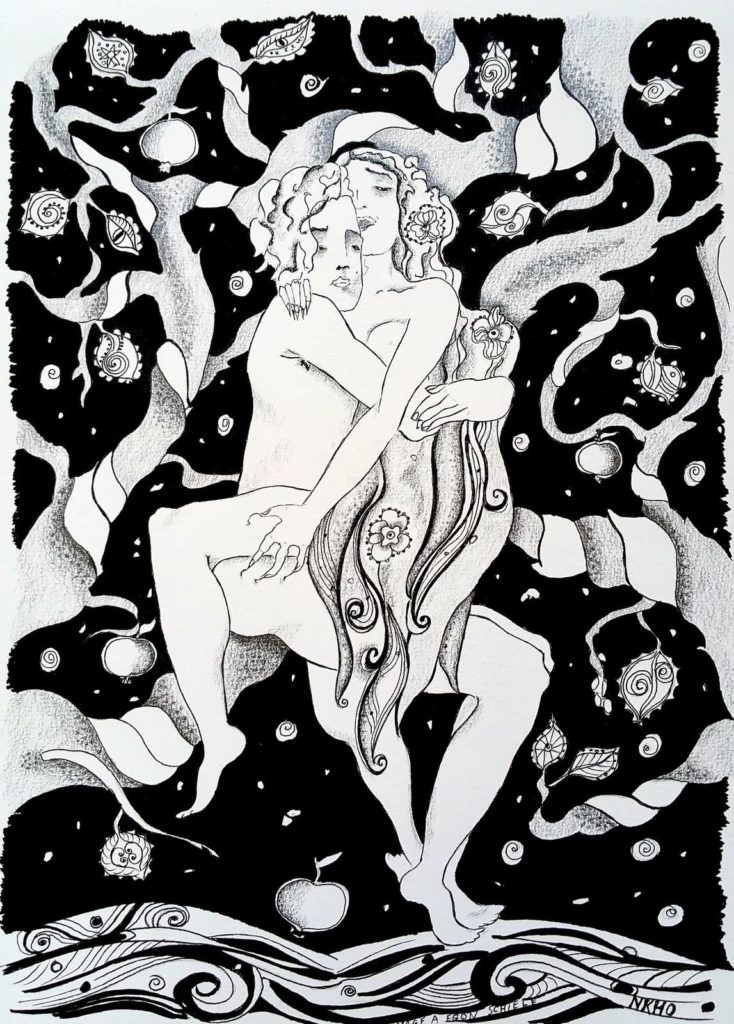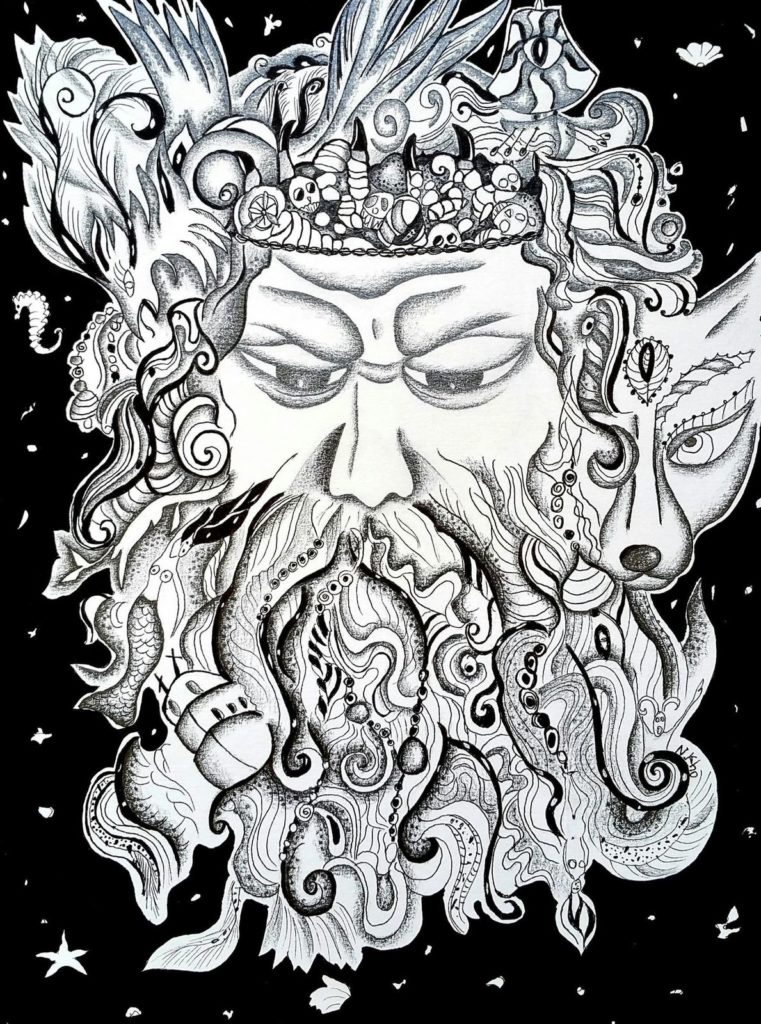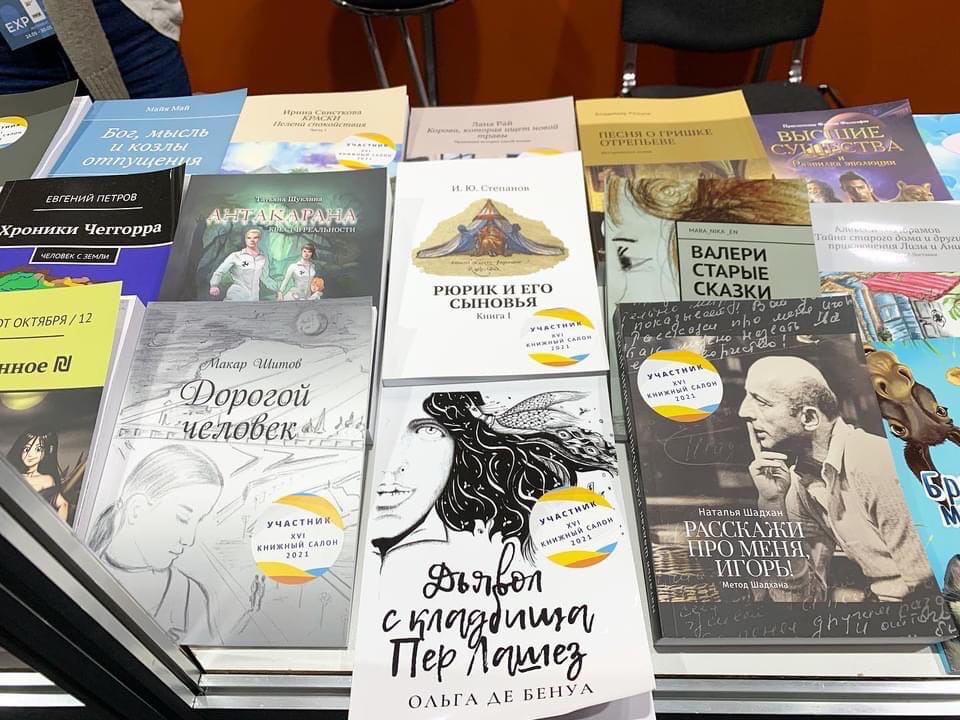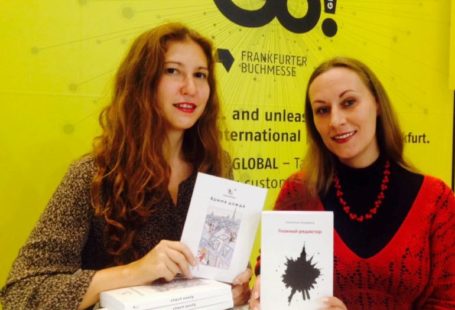FOREWORD : A Review By Elena Reid
The Devil from Père Lachaise by Olga de Benois

“The light shines in the darkness…”
When I set out to write this review, I didn’t know where to begin. How do you approach a fairytale? How do you catch the Firebird by the tail? How do you run beneath a rainbow? Only dreamers can manage such things. But those who are puffed up with their supposed rationality and have lost their reason in the process—trapped by passions, yet afraid to love—such people could never pull the sword from the stone. Aren’t most of us like that? I admit, I haven’t the courage to deny it. Fortunately, we are not beyond hope. In our hearts still live the Little Prince and his rose, our eyes still reflect the Milky Way, we can still hear the stars laughing… or the Moon weeping. All we need to do is believe. Don’t try to besiege a fairytale—it’s not Troy. Don’t try to tame it—it’s not Sivka-Burka. As the hero of the brilliant animated film “Hedgehog in the Fog” once said, “Let the river carry me…” To let a fairytale carry you away, to open up to it—that is the only way to speak with it, to delight in its candor, to come alive again, to breathe… This is my attempt to do just that.
The title “The Devil from Père Lachaise Cemetery” initially puzzled me. I expected something dark, neo-Gothic, almost a vampire novel, full of ghosts and bloody rituals. And while I wasn’t entirely wrong—there is, in one chapter, a torrent of blood spilled, the precious blood of a cruel and shadowy being—is it frightening? Let’s not get ahead of ourselves. The subtitle puts things in perspective: “A Word on Eternal Love.” Olga de Benois is one of those authors who chooses her words carefully. If she says it’s a book about love, then it is. If she states that the genre of the book is not a novella, not a fairytale, not a parable, not a short story, not even a fantasy like Alexander Grin’s, then believe her. And you won’t be disappointed. The “Word” is a genre of Old Russian literature, most familiar to readers from the masterpiece “The Tale of Igor’s Campaign.” Characteristic of this genre is the technique of “weaving words.” The term speaks for itself—a richly adorned language where epithets and sentence structures are strung together, intricately intertwined, rivaling Celtic knots or Arabic calligraphy. This exquisite verbal lace is not the goal, but the means. It builds intense emotional tension and profound psychological depth. The form matches the content—for how else can you cry out to a deaf and indifferent world, how else bring the light of love, if not by setting hearts ablaze with words?
In Olga de Benois’s book, the fire is not infernal, but divine—it is lit in the heart of the Little Devil, and from that moment on, no matter what unfolds, no matter the bacchanalia at Père Lachaise, I believed everything would turn out all right. I followed the hero’s adventures, admired the descriptions of the Mad Fisherman’s carnival, empathized and shuddered—but the fire already burned.
The book captivates—it’s like watching a flickering candle or flowing water. Yet the narrative has a powerful structure, like the trunk of a tree. The trunk of the very Millennial Oak, whose meeting is foretold. In its crown live crows—not because they caw ominously in gothic crypts, but because… Well, once we realize the oak is in fact an ash tree, the symbolism becomes clear. Yggdrasil, whose trunk leads to the Moon… Skulls and blood, the Moon’s tears and laughter, the Philosopher’s Stone, a magical mirror… This story features many symbolic objects, each burdened with centuries of human meaning. But they are given new life, tightly interwoven into a single net (perhaps the Mad Fisherman’s net?). The symbolism is emphasized by the epigraphs. One great pleasure in reading “The Devil from Père Lachaise Cemetery” is to read the epigraph, then the chapter, and then return to the epigraph to uncover all the parallels and threads. Those who enjoy literary play, references, hints, and allusions are in for a true adventure.
So, tears and blood, water and fire, a world tree shading an ancient cemetery, twilight, and then stars—enough for magic, or is something missing? Time. Of course—it’s Christmas Eve. The unity and opposition of death and life. On such a night, the elements rage, and dark beings gather for the Grand Carnival “to stretch their millennial bones, swap city gossip, complain about fuel prices and, why not—since the Devil always jokes—feast on some unsuspecting soul.” But the Little Devil is a brave lover, bearing his love through chaos and darkness, like Danko with his flaming heart torn from his own chest. A chance (or is it?) encounter with the incorrigible adventurer and inspired jester Jim Morrison—and the hero gains a goal. Hope—a dangerous temptation for a lost, cursed being trapped in a cemetery statue for reasons unknown. But if a celestial maiden lives in his soul, and his eyes remember falling stars? “When he looked at the beautiful maiden, he saw that meteor shower. It seemed to him that the falling stars were a guiding thread through the chain of his dark lives. Perhaps he had atoned for his sin and was preparing for rebirth. Or for final disappearance. He did not know.”
How many times during that mad night could the Little Devil have sunk into despair, abandoned hope, vanished altogether? But love is a beacon, and dreams a ship. And we, with the hero, charge forward chivalrously toward his unreachable beloved…
The story’s brisk pace and unity of setting make the narrative feel whole, dense, seamless. A theatrical performance? Or a film? Despite the beauty of its language, descriptions, and lyrical digressions, the book is eventful. Or perhaps a mystery play, a medieval carnival? That’s closer to the truth: when city streets were filled with processions and performances on public squares, all townsfolk joined in. So too, we find ourselves inside the book, like on stage, caught up in the Little Devil’s whirlwind. What a contrast! The riotous blasphemy of the carnival and the sacredness of eternal themes! But our souls, ever since those Dark Ages, since the time of legends and myths—or even Greek tragedies—are used to this edge, though we’ve forgotten our fiery nature in the bustle of everyday life. “A Word on Eternal Love”… You’re joking, right? What love? Better give us money… And eternal? Nonsense! But wait… Listen… Look more closely… Love is the crucible where the ore of our hearts is smelted into noble metal. Yes, it’s painful. Yes, it’s a trial. But don’t be afraid! Good people! I promise you won’t be able to take your eyes off our tale, just like the Little Devil couldn’t look away from that meteor shower.
The characters are vivid and dynamic—you feel like you could touch them. What lovers! The story features a surprising number of harmonious, happy couples—sacrificing for each other, listening to each other, sensitive and attuned. They share each other’s humor—which is hugely important. I won’t reveal all the secrets, dear reader, but believe me: the number of truly loving and beloved characters amazed me—yet didn’t feel unnatural. Again, a contradiction—the story is set in a cemetery, among spirits, shadows, and long-buried greats like Sarah Bernhardt, Molière, Isadora Duncan, and Jim Morrison—and yet there is so much love and readiness to help… A seeming contradiction. A world untainted by malice, envy, or ingratitude—shouldn’t it be just like this?
The Little Devil is not alone. I daresay even the Mad Fisherman, master of the Grand Carnival, is weary of counterfeits and surrogates, and longs for love… He is one of the most brilliantly crafted characters. He is beautiful in his monstrousness, dark, hungry, brooding, and fallen—a repulsive, fascinating figure. I’ll let the author speak:
“The Little Devil stared in horror at the face carved as if from obsidian, still bearing traces of ancient beauty not yet worn away by millennia of passion and excess. On the Mad Fisherman’s curly silver-dusted hair rested a crown woven with snarling animal faces, seaweed, shells, wreckage of ships, planes, and yacht sails. His ring-covered hands with ragged claws lay like whips on the throne’s armrests, strung with the skulls of earthly rulers. His boots—each large enough to house a Père Lachaise crypt—rested on a snarling monster from the Seine.”
You just want to draw him! I think illustrators will love working with “The Devil from Père Lachaise Cemetery”, and I would love to be one of them. The vivid imagery—like the bony “Honda” used as transport, or famous skeletons gambling with Tarot cards atop graves—cries out to be drawn. Stained glass? Graphic novel? Collage? Watercolor? Doesn’t matter—so long as it captures the speed of the living statues, the fragility of translucent tree shadows, the trembling moonlight, and the holiness of eternal love…
If Olga de Benois hadn’t defined her book as a “Word,” I would dare call it a parable. Everything is measured on a scale, and to each is given their due. There is a higher realm toward which all—no, most—many… characters strive. And there is the One, whose radiant day follows the night of chaos and demonic revelry. The triumph of life and transformation after bitter parting, trials, and even death—what is that if not a parable? Perhaps it’s more akin to “The Fisherman and His Soul” (from which there’s also an epigraph) than “The Little Prince.” One thing is certain—“The Devil from Père Lachaise Cemetery” is a universal, multifaceted tale in which many will find—or want to find—themselves…
But beware! This fairytale, or parable, or Word is like the Hairy Witch’s mirror—it shows your true self. Woe to those who wear masks, for where there is love, there is no room for lies. Set off on your journey if courage burns in your heart, if the words “passion,” “tenderness,” and “mercy” are not empty to you—forward, to the Mad Fisherman’s Carnival! Fear nothing, and may dawn find you beside your beloved.
Elena Reid, poet and literary critic







